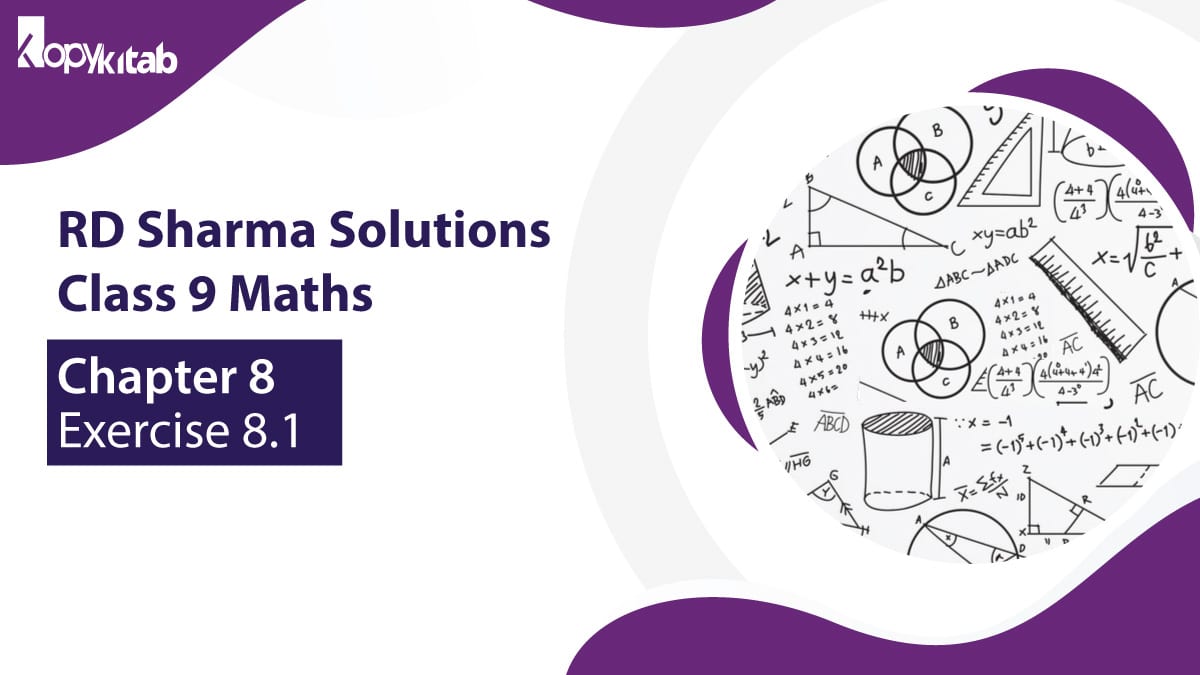We will learn about the Lines and Angles in RD Sharma Chapter 8 Class 9 Maths Exercise 8.1 Solutions. The exercise is all about the Types of Angles, Axioms & Theorems, Angle Bisector, Congruent Angles, etc. To make the concepts easy for the students, we have provided the exercise with easy solutions, which helps them score well in the exam. The questions mentioned in the PDF is taken from the CBSE Text Book, RD Sharma, and Previous Years Question Paper of Class 9. From this chapter, students specifically learn about the formulas and techniques for solving the questions related to the Lines and Angles.
Download the RD Sharma Chapter 8 Class 9 Maths Exercise 8.1 Solutions PDF for free attached below for the students from which they can practice for the exam. There are various types of questions related to the Types of Angles, Axioms & Theorems, etc. By practicing regularly, students get expert in using the formulas and techniques provided by our experts to solve the questions efficiently.
Click Here to know about the Introduction of Lines and Angles
Download RD Sharma Chapter 8 Class 9 Maths Exercise 8.1 Solutions PDF
Solutions for Class 9 Maths Chapter 8 Lines and Angles Exercise 8.1
Important Definitions RD Sharma Chapter 8 Class 9 Maths Exercise 8.1 Solutions
Look down to the following to know the brief about the definitions and illustrations based on the RD Sharma Chapter 8 Class 9 Maths Exercise 8.1 Solutions Lines and Angles. This includes the topics and subtopics, namely-
- Angles
- Interior of an angle
- The exterior of an angle
- Congruent angles
- The measure of an angle
- Axioms and Theorems
- Types of Angles
- 1. Right Angle
- 2. Acute Angle
- 3. Obtuse Angle
- 4. Straight Angle
- 5. Reflex Angle
- Complementary Angles
- Supplementary Angles
- Angle Bisector
Angles
When two rays merge with a common endpoint and the angle is set. The two segments of an angle are “sides” and “vertex.” The side can be classified into terminal sides and initial sides (or vertical surfaces).
Parts of Angles
- Vertex: Point wherever the arms meet.
- Arms: Two straight line segments set of a vertex.
- Angle: If a ray is rotated around its endpoint, the measure of its rotation is known as the angle between its initial and final state.
Classification of Angles
Angles can be categorized based on two main kinds-
- Magnitude
- Rotation
Types of Angles
- Acute Angles- An angle that lies between 0 degrees and 90 degrees (0° and 90°) is known as an Acute Angle. In simple words- an acute angle is one that is less than 90° (90 degrees).
- Obtuse Angles- This angle is the opposite of an acute angle. It is the angle that lies between 90 degrees, and 180 degrees (90° and 180°) is known as an Obtuse Angle. In simple words, an obtuse angle is greater than (90°) 90 degrees and less than 180 degrees (180°).
- Right Angles- A right angle is perpetually equivalent to 90° (90 degrees). Any angle less than 90 degrees (90°) is an acute angle, whereas any angle greater than 90° is an obtuse angle.
- Straight Angles- When measured, a straight angle is 180° (180 degrees). It looks like a straight line because the angle between the arms is 180°.
- Reflex Angles- Any angle with a measure that is greater than 180° though less than 360° (which corresponds with zero degrees) is a reflex angle.
- Full Rotation- An angle equivalent to 360° is known as full rotation or full angle. It is set when one of the arms carries a complete rotation to set an angle.
Interior and Exterior of An Angle
Interior of An Angle
The area between the rays makes an angle and prolonging away from the vertex to eternity.
In simple words, An angle inside a frame, between two connected sides.
The exterior of An Angle
It is the angle between any side of a shape and a line enlarged from the next side.
Congruent Angles
Congruent Angles have the same angle, whether in degrees or radians. Congruent Angles don’t have to point in the same direction. On similar sized lines, it is just the same angle.
The Measure of An Angle
An angle measure can be described as measuring an angle determined by the two rays or arms at a usual vertex. Angles are measured in degrees (°), applying a protractor.
Axioms and Theorems
Axioms: We expect to be true without proof is known as an axiom.
Theorems: A mathematical description that we understand is true, which has a proof is a theorem.
Complementary Angles
When the total of two angles is 90°, then the angles are called the complementary angles. In simple words, if two angles sum up to make a right angle, then these angles are indicated as complementary angles. We can say that the two angles complement each other.
Facts of Complementary Angles
- Two right angles will not complement each other.
- Two obtuse angles will not complement each other.
- Two complementary angles can be acute, but vice versa is impossible.
Supplementary Angles
When the total of two angles is 180 degrees (180°), the angles are called the supplementary angles. In simple words, if two angles sum up to make a straight angle, then those angles are indicated as supplementary angles.
Angle Bisector
“Bisect” anticipates dividing into two equal parts. Angle Bisector means a line that divides an angle into two similar angles.
